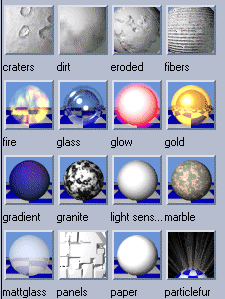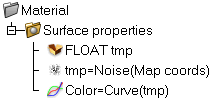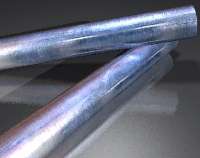

Materials
Assigning Materials to Geometric ObjectsAny number of materials
can be assigned to a single object by using an extremely easy drag &
drop interface. Realsoft 3D includes a large number of predefined materials
which can be combined to create impressive results this way.
 |
Parallel, cylinder, sphere, disk, mesh, cube and pointwise uv mapping methods are available for mapping materials to objects. Mesh mapping is a 2D NURBS surface in the UV space of a parent mesh. Its vertices can be edited along the parent surface, allowing elastic control of the texture map independent of the parent mesh. It is also possible to define arbitrary mapping formulas and procedures. For example, one can map two brushed steel materials to a single surface and rotate the mapping objects to get scratches in two directions. |
Realsoft 3D introduces a revolutionary new material system featuring visual shading language. VSL provides the end user with a power equal to programming languages, but is much easier to use. The system allows the end user to define procedural material effects such as fire, marble, or wood without writing a single line of code. All materials shipped with Realsoft 3D are actually created using VSL.

A tool bar showing
VSL objects. To create a VSL material, simply drag & drop these to
your material.
VSL materials are built from two kind of elements: VSL objects (Constant, Texture, Noise, etc.) and material properties (Transparency, Alpha, Color, etc.). The simple but powerful principle is that any of the VSL objects can be used for defining any of the material properties.
If you use 'Constant' VSL object to define 'Color', you will get a constant color for a surface. Use a 'Texture Map' object to define 'Color' for standard texture mapping. Or use a 'Texture' object to define 'Reflection' to achieve a reflection map.

A 'Granite' material.
Three VSL objects dragged & dropped into a 'Surface properties' VSL
object. A Curve VSL object defines the Color material property.
It is really this simple. Just like you can modify properties of a geometric sphere, you can modify properties of a VSL object. A 'Constant' VSL object defines only one attribute i.e. the value to be assigned into a surface property. A 'Curve' object defines a set of curves which define how a certain property varies over a surface.

A 'Curve' VSL
object selected. The property window allows you to edit curve specific
attributes.
Open, Expandable Channel System
What makes the material system of Realsoft 3D so revolutionary is that there is no fixed set of properties. The user can create any number of custom material properties. In addition to color, transparency, refraction factor and other 'built-in' properties you now have freedom to create your own material properties. For example, define a new material property 'Age' and create a material which uses bump mapping so that the older the object gets, the more scratches appear on it.

Brushed steel
demonstrating anisotropic rendering
These new custom
channels can be transformed, pipelined to do compositing or shading effects,
etc. The consistent use of channels makes mind-blowing effects possible
and easy. For example, one can define a light source which casts a beam
of gamma rays whose intensity is defined by a texture map. The gamma rays,
in turn, make objects glow according to the intensity of the radiation
on a target object's surface! And this is not all, one can also render
an image including this new gamma glow property, and use it as a texture
map or a mask for compositing effects. All this is possible without the
need to write complex formulas or use a programming language!
Any Channel can be rendered to an Image
Any one of the defined
material properties (channels) can be rendered to a final image for use
in post processing, as a texture map and other uses. In addition to 'color',
'alpha', 'depth', etc. feel free to render images which contains age of
objects, or whatever other material or object property. This opens endless
applications for post processing.
 |